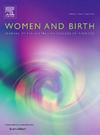Who is in the centre? A qualitative study on midwives’ experience of working with central fetal monitoring system
IF 4.4
2区 医学
Q1 NURSING
引用次数: 0
Abstract
Background
Central fetal monitoring systems are widely used and assumed to improve perinatal outcomes. However, there is a lack of studies focusing on midwives’ experiences in maternity services where central fetal monitoring technologies have been introduced.
Aim
The aim is to describe midwives’ experiences of working in a birthing service where a central fetal monitoring system had been recently introduced.
Method
Qualitative descriptive design. Three focus groups interviews were conducted with 18 midwives in a birthing service of a teaching hospital in Iceland. Content analysis was used to analyse the data set.
Findings
The main themes were 'the screen affects everything' and 'the technology has come to stay'. Midwives experienced a sense of being under surveillance, and modified their documentation to meet the information needs of staff at the central monitoring station. Experiencing unrequested visits from obstetric staff challenged midwives’ self-confidence, particularly if they were new to practice. Midwives reported tension in balancing the conflicting demands of being continuously present with the labouring woman and freedom to leave the room. Feeling that CTG interpretation was now a shared responsibility with medical staff was perceived as positive, but also altered the way midwives and doctors collaborated.
Conclusions
Introducing central fetal monitoring technology affected the culture of the birthing service in ways that may shape midwives’ perception of being a “good midwife”. The relationship between midwifery professional standards and the beliefs embedded in birth technology should be considered critically, rather than accepting that the “technology has come to stay”.
求助全文
约1分钟内获得全文
求助全文
来源期刊

Women and Birth
NURSING-OBSTETRICS & GYNECOLOGY
CiteScore
7.20
自引率
13.20%
发文量
371
审稿时长
27 days
期刊介绍:
Women and Birth is the official journal of the Australian College of Midwives (ACM). It is a midwifery journal that publishes on all matters that affect women and birth, from pre-conceptual counselling, through pregnancy, birth, and the first six weeks postnatal. All papers accepted will draw from and contribute to the relevant contemporary research, policy and/or theoretical literature. We seek research papers, quality assurances papers (with ethical approval) discussion papers, clinical practice papers, case studies and original literature reviews.
Our women-centred focus is inclusive of the family, fetus and newborn, both well and sick, and covers both healthy and complex pregnancies and births. The journal seeks papers that take a woman-centred focus on maternity services, epidemiology, primary health care, reproductive psycho/physiology, midwifery practice, theory, research, education, management and leadership. We also seek relevant papers on maternal mental health and neonatal well-being, natural and complementary therapies, local, national and international policy, management, politics, economics and societal and cultural issues as they affect childbearing women and their families. Topics may include, where appropriate, neonatal care, child and family health, women’s health, related to pregnancy, birth and the postpartum, including lactation. Interprofessional papers relevant to midwifery are welcome. Articles are double blind peer-reviewed, primarily by experts in the field of the submitted work.
 求助内容:
求助内容: 应助结果提醒方式:
应助结果提醒方式:


